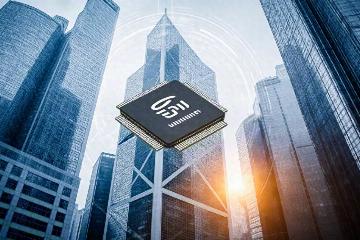Micron Shares Plunge 16% on Weak Forecast
Advertisements
On December 19, 2023, Micron Technology (MU.O) published its financial report for the first quarter of fiscal year 2025, which ended on November 28, 2023. The company, a prominent player in the semiconductor memory industry, has faced challenges in the consumer market, leading it to lower its revenue expectations for the second quarter of the fiscal year 2025. Following the announcement, Micron's stock plummeted by over 16% in after-hours trading.
Micron Technology stands as the third-largest semiconductor memory manufacturer globally. headquartered in the United States, it specializes in high-performance DRAM (Dynamic Random Access Memory) and NAND flash memory productsThese components are fundamental in a variety of applications ranging from smartphones and personal computers to automotive and industrial systems, as well as increasingly in AI and medical devicesThe company's diverse portfolio showcases its significant role in the tech industry's advancement.
According to the latest financial disclosures, Micron reported revenues of $8.7 billion for the last quarter, marking an impressive year-on-year increase of 84% and a quarter-over-quarter growth of 12%. The gross margin improved to 40%, reflecting a robust upward trend compared to previous periods
Notably, the net profit surged to $2 billion, a stark contrast to a loss reported in the same quarter of the previous year, indicating a 52% increase quarter-over-quarter.
An analysis of Micron's product revenue reveals a significant focus on DRAM, which accounted for 73% of its total income compared to 26% from NANDThe relationship between these two primary product categories showed a shift, with DRAM seeing both revenue and shipment increases while NAND experienced declines in these metricsAdditionally, Micron noted a modest increase in the average selling price (ASP) for DRAM, contrasted by a slight downturn for NANDThis data highlights the growing importance of DRAM in Micron's overall business strategy compared to NAND memory products.
In terms of capital expenditures, last quarter Micron's spending reached $3.1 billionFor the current quarter, the company anticipates expenditures around $3 billion, with a total forecast for fiscal year 2025 set at approximately $14 billion
- All Three Major U.S. Indices Rise Over 1%
- Stable Trends in the Global Commodity Market
- Learning from the Historical Lessons of Protectionism
- Micron Shares Plunge 16% on Weak Forecast
- Do AI Creators Regret Spending $200 on Sora?
A significant portion of this investment is earmarked for the development of high-bandwidth memory (HBM), which is pivotal for AI computing needs, alongside supporting factory construction and R&D initiativesNotably, Micron has curtailed its NAND investments and is carefully managing the pace of technological advancement within that sector to control product supply effectively.
During the earnings call, Micron's management provided a sobering outlook for the second quarter, forecasting revenues and net income to fall below first-quarter figuresProjected revenue is set at $7.9 billion, down from $8.7 billion, with diluted earnings per share estimated at around $1.43, a decrease from $1.79. The revision of expectations has been attributed to various factors, including inventory adjustments in consumer markets, seasonal fluctuations, and a cooling off in data center operations that had enjoyed rapid growth over recent quarters.
Despite challenging conditions in the consumer market, Micron continues to see a robust demand for its memory products driven by AI applications
In fact, revenue from data centers for this quarter exceeded 50% of total revenues for the first time, boasting a staggering year-on-year growth of 400%. The HBM revenue nearly doubled from the previous quarter, suggesting that HBM technology could generate billions in revenue for Micron throughout fiscal year 2025.
Micron is often lumped together with Samsung Electronics (005930.KS) and SK Hynix (000660.KS) as one of the world's leading memory manufacturersAccording to market research firm TrendForce, these three companies dominate the DRAM and NAND markets, ranked respectively as first, second, and third globallyWithin the DRAM space, HBM has taken center stage as one of the most critical categories driven by the demand for high-performance storage from AI chips.
Both Samsung and SK Hynix, alongside Micron, have embarked on developing and marketing the fifth-generation HBM product, known as HBM3E, with 12 layers designed to deliver superior performance
The competition among these firms is fierce, with Hynix currently holding a lead position after announcing the commencement of mass production of its HBM3E products in SeptemberReports indicate that Hynix commands a significant share of the HBM market—an advantage it looks to maintain as it fulfills contracts primarily with industry leaders like Nvidia.
Although Samsung has lagged behind Hynix regarding HBM3E technology, the company is actively ramping up its production capabilitiesIn its third-quarter financial report released in September, it revealed that HBM3E was nearing mass production—however, it accounted for less than 10% of its HBM revenue at the timeBeauty Micron disclosed in its latest earnings report that it has successfully shipped HBM3E to multiple clients, indicating potential for further market share growth.
Looking ahead, experts from Counterpoint have expressed that while HBM prices are expected to decline gradually due to technological advancements and improved yield rates, the market's supply constraints may keep prices elevated

A strong demand coupled with high production costs means that significant price drops may not be imminentIn the near term, the continued demand often keeps HBM prices buoyed at high levels, reflecting its critical role in contemporary computing environments.
In the realm of AI, HBM is seen as an essential high-speed memory technology, while NAND serves as a substantial storage solutionThe industry is currently witnessing a transition from 2D NAND to 3D NAND technologies, with 3D NAND gaining traction due to its superior capacity and performance, making it increasingly popular among downstream clientsThe competitive landscape in the NAND sector features distinct strategies from the three top manufacturers: Samsung boasts the most comprehensive NAND product line, covering segments from entry to premium levels, while SK Hynix focuses on innovative architectures, including QLC technology, targeted primarily at data center applications
post your comment